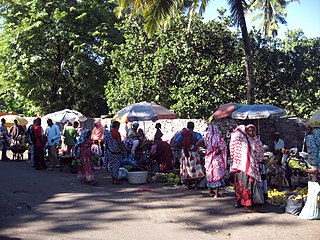
This page is an overview of the economy of Wallis and Futuna .

This page is an overview of the economy of Wallis and Futuna .
The GDP of Wallis and Futuna in 2005 was 188 million US dollars at market exchange rates. [1] The GDP per capita was 12,640 US dollars in 2005 (at market exchange rates, not at PPP), which is lower than in New Caledonia, French Polynesia, and all the other French overseas departments and territories (except Mayotte), but higher than in all the small insular independent states of Oceania.
Along with the French territories of New Caledonia and French Polynesia, the territory uses the CFP Franc, which is fixed vs. the euro, at the rate of 1,000 XPF = 8.38 euro. In 1991, BNP Nouvelle-Calédonie, a subsidiary of BNP Paribas, established a subsidiary, Banque de Wallis et Futuna, which currently is the only bank in the territory. Two years earlier Banque Indosuez had closed the branch at Mata-Utu that it had opened in 1977, leaving the territory without any bank.
The territory's economy is limited to traditional subsistence agriculture, with about 80% of the labor force earning its livelihood from agriculture (coconuts and vegetables), livestock (mostly pigs), and fishing. Agricultural products include breadfruit, yams, taro, bananas, pigs, and goats.
Industries include copra, handicrafts, fishing, and lumber. In 2007, US$63 million worth of commodities (foodstuffs, manufactured goods, transportation equipment, fuel, clothing) were imported, primarily from France, Singapore, Australia, and New Zealand, and there were no exports (the previous year, in 2006, exports amounted to US$122,000 and consisted entirely of 19 tons of trochus shells). [2] About 4% of the population is employed in government. Revenues come from French government subsidies, licensing of fishing rights to Japan and South Korea, import taxes, and remittances from expatriate workers in New Caledonia, French Polynesia and France.

The CFA franc is the name of two currencies, the West African CFA franc, used in eight West African countries, and the Central African CFA franc, used in six Central African countries. Although separate, the two CFA franc currencies have always been at parity and are effectively interchangeable. The ISO currency codes are XAF for the Central African CFA franc and XOF for the West African CFA franc. On 22 December 2019, it was announced that the West African currency would be replaced by an independent currency to be called Eco.
The economy of French Polynesia is one of a developed country with a service sector accounting for 75%. French Polynesia's GDP per capita is around $22,000, one of the highest in the Pacific region.
The economy of French Guiana is tied closely to that of mainland France through subsidies and imports. Besides the French space center at Kourou, fishing and forestry are the most important economic activities in French Guiana. The large reserves of tropical hardwoods, not fully exploited, support an expanding sawmill industry which provides saw logs for export. Cultivation of crops is limited to the coastal area, where the population is largely concentrated; rice and manioc are the major crops. French Guiana is heavily dependent on imports of food and energy. Unemployment is a serious problem, particularly among younger workers.
The economy of Martinique is mostly based in the services sector. Agriculture accounts for about 6% of Martinique's GDP and the small industrial sector for 11%. Sugar production has declined, with most of the sugarcane now used for the production of rum. Banana exports are increasing, going mostly to France. The bulk of meat, vegetable, and grain requirements must be imported, contributing to a chronic trade deficit that requires large annual transfers of aid from France. Tourism has become more important than agricultural exports as a source of foreign exchange. The majority of the work force is employed in the service sector and in administration.

New Caledonia is a major source for nickel and contains roughly 10% of the worlds known nickel supply. The islands contain about 7,100,000 tonnes of nickel. With the annual production of about 107,000 tonnes in 2009, New Caledonia was the world's fifth largest producer after Russia (266,000), Indonesia (189,000), Canada (181,000) and Australia (167,000). In recent years, the economy has suffered because of depressed international demand for nickel, due to the ongoing global financial crisis. Only a negligible amount of the land is suitable for cultivation, and food accounts for about 20% of imports. In addition to nickel, the substantial financial support from France and tourism are keys to the health of the economy. In the 2000s, large additions were made to nickel mining capacity. The Goro Nickel Plant is expected to be one of the largest nickel producing plants on Earth. When full-scale production begins in 2013 this plant will produce an estimated 20% of the global nickel supply. However, the need to respond to environmental concerns over the country's globally recognized ecological heritage, may increasingly need to be factored into capitalization of mining operations.
The economy of Réunion has traditionally been based on agriculture. Sugarcane has been the primary crop for more than a century, and in some years it accounts for 85% of exports. The government has been pushing the development of a tourist industry to relieve high unemployment, which amounts to more than 40% of the labour force.

Wallis and Futuna, officially the Territory of the Wallis and Futuna Islands is a French island collectivity in the South Pacific, situated between Tuvalu to the northwest, Fiji to the southwest, Tonga to the southeast, Samoa to the east, and Tokelau to the northeast.
The economy of Mayotte is based primarily on the agricultural sector, including fishing and livestock raising. The island of Mayotte is not self-sufficient and must import a large portion of its food requirements, mainly from Metropolitan France. The economy and future development of the island are heavily dependent on French financial assistance, an important supplement to GDP. Mayotte's remote location is an obstacle to the development of tourism.

The economy of the Comoros is based on subsistence agriculture and fishing. Comoros has inadequate transportation links, a young and rapidly increasing population, and few natural resources. The low educational level of the labor force contributes to a subsistence level of economic activity, high unemployment, and a heavy dependence on foreign grants and technical assistance. The Comoros, with an estimated gross domestic product (GDP) per capita income of about $700, is among the world's poorest and least developed nations. Although the quality of the land differs from island to island, most of the widespread lava-encrusted soil formations are unsuited to agriculture. As a result, most of the inhabitants make their living from subsistence agriculture and fishing. Average wages in 2007 hover around $3–4 per day.

The economy of France is a highly developed, market-oriented economy. It is the world's fith-largest economy by 2022 nominal figures and the ninth-largest economy by PPP, constituting 3.3% of world GDP. It is the 2nd largest economy of Europe, after the economy of Germany.

The CFP franc is the currency used in the French overseas collectivities of French Polynesia, New Caledonia, and Wallis and Futuna. The initials CFP originally stood for colonies françaises du Pacifique. This was later changed to Communauté financière du Pacifique and then to its present term, Change franc Pacifique. Its ISO 4217 currency code is XPF.
A territorial collectivity is a chartered subdivision of France, with recognized governing authority. It is the generic name for any subdivision with an elective form of local government and local regulatory authority. The nature of a French territorial collectivity is set forth in Article 72 of the French Constitution of 1958, which provides for local autonomy within limits prescribed by law.

The Fédération du Scoutisme Français is an umbrella organization that combines the efforts of the several Scouting and Guiding associations in France and also represents the Scouting movement in French Guiana, Martinique, Saint-Pierre and Miquelon, New Caledonia, Réunion, Wallis and Futuna and Guadeloupe. Until 2012 the Muslim Scouts of France were presiding the Federation with Dr. Younès F. Aberkane as president.
The French overseas collectivities, are first-order administrative divisions of France, like the French regions, but have a semi-autonomous status. The COMs include some former French overseas colonies and other French overseas entities with a particular status, all of which became COMs by constitutional reform on 28 March 2003. The COMs differ from overseas regions and overseas departments, which have the same status as metropolitan France but are located outside Europe. As integral parts of France, overseas collectivities are represented in the National Assembly, Senate and Economic and Social Council and can vote to elect members of the European Parliament (MEPs). The Pacific COMs use the CFP franc, a currency pegged to the euro, whereas the Atlantic COMs use the euro itself. As of 31 March 2011, there were five COMs:

For elections in the European Union, Overseas Territories was a European Parliament constituency in France until the 2019 European Parliament election. It consisted of all the inhabited French overseas departments and collectivities, even if their territory is not part of the European Union. Constitutionally, all French citizens are also granted the same European citizenship, consequently all of them elected representatives in the European Parliament, independently of their area of residence.

Overseas France consists of thirteen French-administered territories outside Europe, mostly the remains of the French colonial empire that chose to remain a part of the French state under various statuses after decolonization. This collective name is used in everyday life in France but is not an administrative designation in its own right. Indeed, the five overseas regions have exactly the same administrative status as the metropolitan regions while the five overseas collectivities are semi-autonomous and New Caledonia is an autonomous territory. Overseas France includes island territories in the Atlantic, Pacific and Indian Oceans, French Guiana on the South American continent, and several peri-Antarctic islands as well as a claim in Antarctica. Excluding the district of Adélie Land, where French sovereignty is effective de jure by French law, but where the French exclusive claim on this part of Antarctica is frozen by the Antarctic Treaty, overseas France covers a land area of 119,396 km2 (46,099 sq mi) and accounts for 18.0% of the French Republic's land territory. Its exclusive economic zone (EEZ) of 9,825,538 km2 (3,793,661 sq mi) accounts for 96.7% of the EEZ of the French Republic.
The economy of Saint Martin, divided between the French Collectivity of Saint Martin and the Dutch Sint Maarten, is predominately dependant on tourism. For more than two centuries, the main commodity exports have generally been salt and locally grown commodities, like sugar.

Although the European portion of France is part of the Schengen Area, its overseas departments, collectivities and other territories apply their own visa policies, which have some additional exemptions or restrictions compared to the visa policy of the Schengen Area.
![]() Media related to Economy of Wallis and Futuna at Wikimedia Commons
Media related to Economy of Wallis and Futuna at Wikimedia Commons